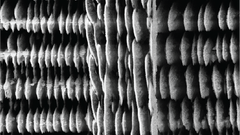3D printing method may improve micro energy storage
One key to making portable devices more compact and energy efficient lies in the precise nanoscale form of energy-storing capacitors. Researchers in Sweden report they've cracked the challenge with a unique 3D printing method.

Researchers at KTH Royal Institute of Technology demonstrated a 3D printing method for fabricating glass micro-supercapacitors (MSCs) that reduces the complexity and time required to form the intricate nanoscale features MSCs need.
The advance could potentially lead to more compact and energy-efficient portable devices, including self-sustaining sensors, wearable devices and other Internet of Things applications, says Frank Niklaus, professor of micro- and nanosystems at KTH. Their study was published in ACS Nano.
The new method addresses two key challenges to fabricating such devices. A micro-supercapacitor's performance is largely determined by its electrodes, which store and conduct electrical energy. So they need more electrode surface area, and they need nanoscale channels to facilitate rapid ion transport. Po-Han Huang, who was lead author of the study at KTH, says the new research addresses both challenges with through ultrashort laser pulse 3D printing technology.
The researchers discovered that ultrashort laser pulses can induce two simultaneous reactions in hydrogen silsesquioxane (HSQ), a glass-like precursor material. One reaction results in the formation of self-organized nanoplates, while the second converts the precursor into silicon-rich glass, which is the foundation of the 3D printing process. This enables the fast and precise fabrication of electrodes with plenty of open channels, which maximizes surface area and speeds up ion transport.
The researchers demonstrated the approach by 3D-printing micro-supercapacitors that performed well even when charged and discharged very quickly.
"Our findings represent a significant leap forward in microfabrication, with broad implications for the development of high-performance energy storage devices," Huang says. "Beyond MSCs, our approach has exciting potential applications in fields such as optical communication, nanoelectromechanical sensors and 5D optical data storage."
The implications are also significant for technologies presently in common use. Supercapacitors of the non-micro type are already collecting energy generated during braking, stabilizing power supply in consumer electronics, and optimizing energy capture in renewable energy, Niklaus says. "Micro-supercapacitors have the potential to make these applications more compact and efficient."
Contacts
Frank NiklausProfessorKTH Royal Institute of Technology
frank@kth.seImages

Subscribe to releases from KTH Royal Institute of Technology
Subscribe to all the latest releases from KTH Royal Institute of Technology by registering your e-mail address below. You can unsubscribe at any time.
Latest releases from KTH Royal Institute of Technology
Study explains why new kinds of steel needed to build lead cooled reactors11.12.2025 14:23:59 CET | Press Release
Safer operation, better fuel efficiency and lower waste mark lead-cooled nuclear power as a potentially dramatic shift from the water-cooled nuclear stations the world has relied on since the mid 20th century. A recent Swedish study casts new light on how to avoid corrosion in the steel used to build these next-generation nuclear facilities.
Alternative to BPA passes toxicity and sustainability standards set by EU innovation guidelines4.12.2025 11:07:37 CET | Press Release
Polyester and a host of other plastic products could potentially be manufactured with non-toxic and sustainable BPA alternatives identified in a multidisciplinary study published today by researchers in Sweden.
Study shows potential for more affordable and efficient hydrogen gas production3.12.2025 15:29:35 CET | Press Release
A recent advance in the science of hydrogen fuel production could enable higher output and more sustainable production of this renewable energy source, researchers with Stockholm’s KTH Royal Institute of Technology report.
Calcium-sensitive switch designed to boost efficacy of cancer drugs24.11.2025 21:11:53 CET | Press Release
Cancer-fighting antibody drugs are designed to penetrate tumor cells and release a lethal payload deep within, but too often they don’t make it that far. A new study shows how this Trojan Horse strategy works better by exploiting calcium differences outside and inside cells.
Potential treatment may prevent brain damage in premature babies11.11.2025 11:10:46 CET | Press Release
A treatment that could protect premature babies from brain damage showed promise in a recent study in Sweden. Using a first-of-its-kind prenatal brain model created with human cells, researchers observed new details about the effects of cerebral hemorrhages on stem cells during premature birth. And they successfully tested an antidote that reduced the damage.
In our pressroom you can read all our latest releases, find our press contacts, images, documents and other relevant information about us.
Visit our pressroom